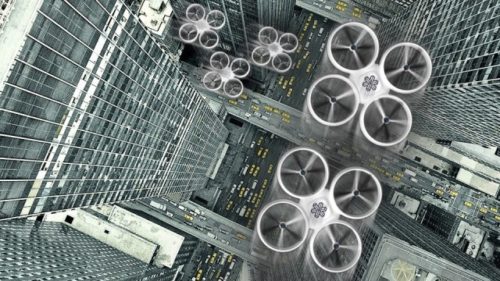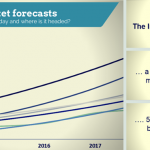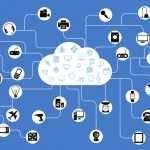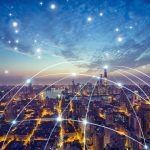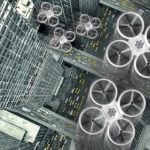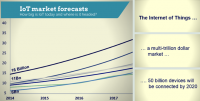The secret system that will backbone the entire IoT industry
The secret system that will backbone the entire IoT industry

No one thinks about the systems that connect us today. It’s not sexy, it doesn’t control the temperature in your house and it doesn’t tell you your heart rate. But that universal system is responsible for more almost everything that runs in the world today.
Roads, houses, time, rockets and everything in between are connected because of this ancient protocol.
See also: How IoT and citizen science can tackle urban disadvantage
Some people say it was invented by aliens, but regardless, the ancient metric system is responsible for measuring time, months, our calendar and almost every culture — outside of the US, of course — uses it as a standard to measure almost everything. It’s one of the largest connected standards in history.
This system was built by humans through slow evolution. The backbone system that will support the IoT industry will be something that operates on its own. This lack of standardization is the largest gap that’s holding back a massive flood of advanced technological capabilities.
We will need to build the new IoT standardization with agility in mind. Engineers will need be able to mold it for future technologies that will work on deep AI….but that’s another op-ed.
What IoT really is: a common misconception
Many people associate IoT with their Nest thermostat and August lock, but if you drill down to the basics of IoT, it is literally two devices exchange information without human input. A device that senses human heartbeat, distance run or body temperature isn’t really IoT.
The IoT backbone will be built on data collection, and what machines can do with that data.
Some of this future is in development, or already here.
Aeva by Olaeris, an autonomous aircraft project, is a great example of what happens when a collected data set. Built with technology that can man an entire flight without human interaction is built. This drone allows civilians to move up to the 10,000′ in altitude that consumer aircraft are limited to by the Federal Aviation Administration.
Connectedness between the online and offline world faces the same standardization challenges. The same type of challenges are happening with autonomous cars. The technology is there, thousands of miles have been driven, but because there is no standardization, there’s no regulation.
Astro Digital is a great example of building a standard data set for the IoT industry in agriculture. Their system is based on data collection. Tracking device data is taken from satellites, software analyzes how much fertilizer is in a field, and then builds its own route to spread the right amount of fertilizer on it’s own, throughout the year.
Broken systems can order their own parts
If something breaks, it sends a signal to a repair station that can automatically order the replacement part from the factory. Then it automatically brings the part in and meets a technician at the location of the repair. The only human interaction needed is the technician making the repair on site.
This works for a pipeline example, too. Each section has a small device tracking to make sure everything’s running smoothly in that section, and all of the sections are communicating. If any monitoring numbers aren’t normal, it checks the other locations to see if it’s normal or abnormal, and creates a diagnosis. If it’s in risk of a malfunction or catastrophe — like a fire — it can shut down automatically. A drone can then fly in to fix it.
What’s interesting about IoT technology is that we’ve got it already. But generally speaking, it’s too expensive. People are still the cheaper solution.
In the long term it will become cheaper to have a machines fixing most of the machinery and technology over a lifetime. This is when we’ll start seeing the industry growing quickly.
How to fill the missing (engineering) gaps
There’s a lot of home automation holes to fill. Smart plugs could measure electricity usage and automatically optimize for the most efficient usage. The electric company’s power meter could talk to the coffee maker and report when it’s using too much power, yes. So why aren’t we doing it now?
It boils down to cost. If the massive utility providers would spend a tiny amount of the billions they make every year, we’d be saving money in our homes immediately, but that doesn’t fit their earning goals.
The lock on your front door could say that you’re coming home, turn on the coffee maker and the AC (in the rooms you’ll most likely be in) and the appropriate lights. But all of this requires a standard protocol between hardware makers, software and a lot of companies pushing to make it happen.
The missing part to all of this IoT connectedness is the system to run it. Think about all of the different protocols and systems these physical devices use to operate. Think about all of the APIs needed to work in sync, not to mention circuitry, electronics and different types of engineering used in them. Machines just don’t talk to each other.
Apple is trying to build and the iPhone standard protocol, Nest has a standard and so on. If we had a wider standard protocol, it would grow the market quickly because it’s easier to adapt hardware to use it. It sets the same rules of the game.
Creating universal standards of collecting data
The problem is you need hardware companies, software companies, and all of the big data is already owned by those who are collecting it, and in many cases, it’s hard to get this data.
Mike Kokorich, entrepreneur, investor and co-founder of Astro Digital, a satellite company focused on connecting the world using data talked with me about the IoT backbone. He’s working on a project that collects data through multi-spectral cameras taken of the Earth.
They enhance their goals by investing in Aerostate, collecting data from sensors on everything from car movement, emissions and many more to produce air quality data. This date is used this in different advanced markets like mobile health, fitness, smart homes, real estate.
“People see IoTas the next internet-sized type of technological advancement,” Kokorich says. “The internet as we know it now was built for people. IoT allows people to create a reality however they want, virtually.”
People are wanting to create a virtual duplicate of the fields in agriculture to predict crop yield, disease and much more. With VR you can make a model with built in forecasts that give accurate advice for farmers so they have a more efficient physical reality, or forecast the physical reality of the future.
Farmers need to know moisture content, how much ozone is in the air or pollution around the land. When you have all of this information, you can create a virtual reality that makes good predictions and solves problems better. Understanding when to spray for fungus to as far as knowing how this crop will affect prices for commodities are both well within reach.
This technology, and ones like it, are the gate between physical and virtual reality. They collect info from space that helps an entire industry and combine that data with satellite meteorological signals to do much more.
How far away is this tech from real operations?
We have a long way to go. It will will start with big data collections, and using it to connect physical applications together.
Helios Wire intend to launch 20 to 30 satellites that collect info from sensors that are located outside of terrestrial networks. The focus is to collect data that’s not covered by terrestrial networks, like mobile signals.
On the connectivity side, some of the low bandwidth systems will dominate — like Sigfox in urban areas. For remote areas, satellites will rule. The internet is where people are, so satellites will be the data collection source for rural areas.
We see this explosion of the drones, of satellites and it’s a reflection of IoT spreading. It’s not just connectivity; it’s data collection, it’s VR and we can get critical info humans have never had access to before by collection this data.”
IoT is creating a system that isn’t human, that operates on its own. This will usher in the next large shift in industry, health and innovation. This is a particularly interesting field because it’s pushing the boundaries of the next phase of technology, where machines don’t need us to get more things done.
The post The secret system that will backbone the entire IoT industry appeared first on ReadWrite.
(20)

